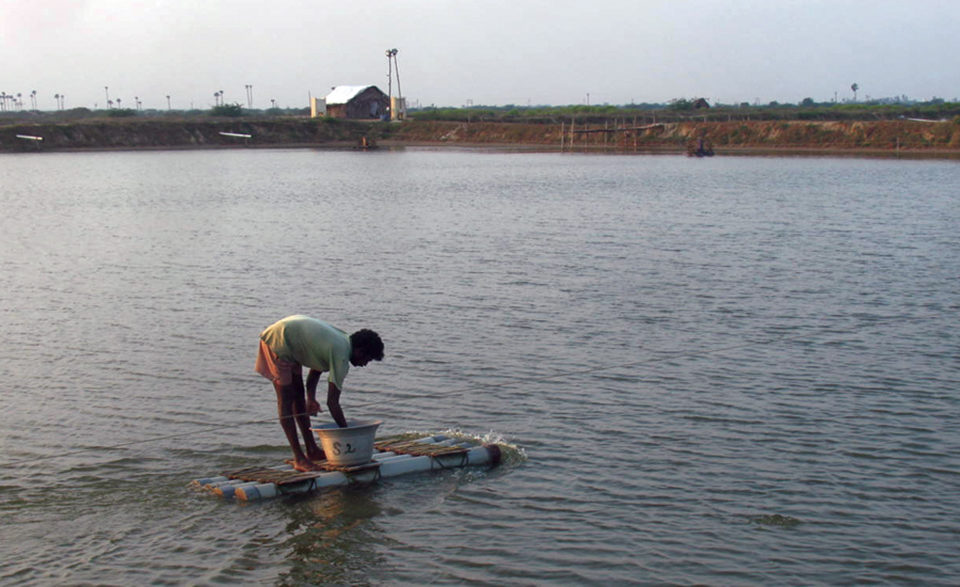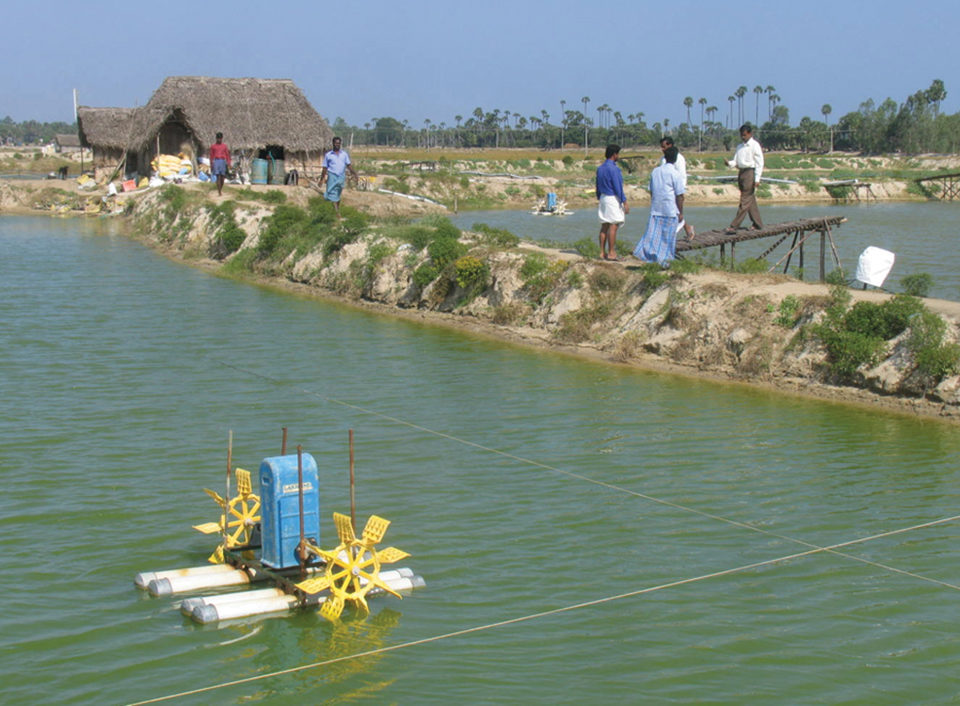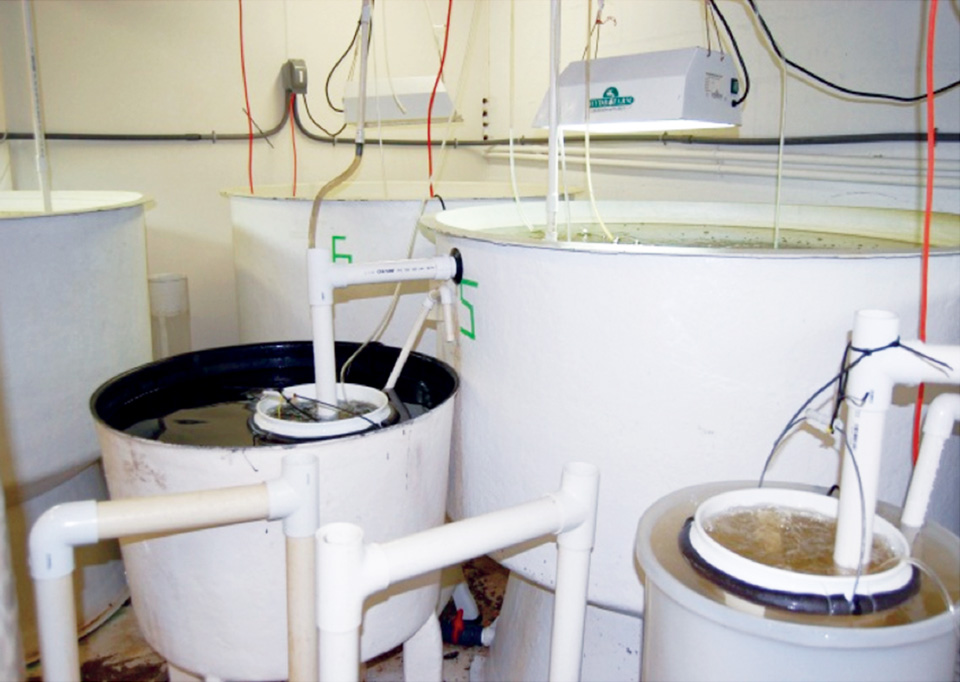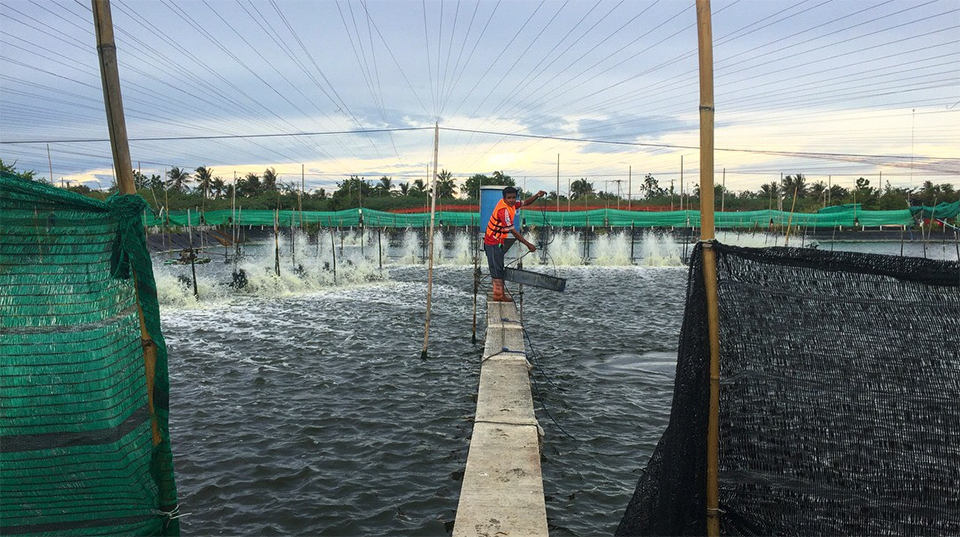Trends, future prospects and adaptation

In 2008, about 34 percent (live weight equivalent) of the world food fish production was internationally traded, with a value of $95.2 billion. New markets are emerging worldwide. There is a clear need for aquaculture farmers to improve the quality and safety of their products in order to gain wider access to export markets.
However, about 70 to 80 percent of aquaculture farms in Asia are small-scale operations, and they can become uncompetitive as they strive to meet the more stringent requirements of export markets. The lack of competitiveness could drive them out of the sector. Empowering small farmers to become competitive in global trade is becoming urgent, and, perhaps, a significant corporate social responsibility.
Small-scale farmers are productive and innovative, but for commodities such as shrimp, they face increasing trade and market-related problems, including costs associated with scale and modern business structures; inequitable access to markets and market information; difficulties in accessing financial and technical services; and increasingly high production, food safety, quality assurance and certification requirements.
Present seafood market trends are not working in favor of small-scale aquaculture farmers. The social and economic implications of these trends will be severe in many coastal rural areas in Asia. As shrimp farming modernizes, many of Asia’s smaller and most vulnerable farmers will be left behind.
Family operations
Small-scale aquaculture farms are difficult to define precisely, but are characterized by small land and water areas, and family-scale operations using family labor that are often based on family land. They often face inequitable access to technical and financial resources. The number of small-scale shrimp farms in Asia is difficult to assess, but it is clear that small-scale farmers make up a high proportion of the sector in many countries.
For example, in Thailand, aquaculture is dominated by small-scale farmers in coastal and inland areas. Of the 33,411 shrimp farmers in Thailand, the Department of Fisheries classifies an estimated 28,400 farmers as “small-scale” with less than 1.6 ha of farm area.
In Vietnam, aquaculture is also dominated by small-scale farmers, mirroring the structure of the rural agricultural economy. The shrimp industry until recently mainly produced Penaeus monodon, but following various policy decisions is now growing more exotic Litopenaeus vannamei white shrimp. The smaller shrimp farmers, whose methods are still dominated by low inputs, cover 85 to 90 percent of the farming area. The number of farmers involved is more than 300,000, with many small-scale businesses involved along the shrimp supply chain.
Certification trend
The need to respond to social, environmental and consumer concerns regarding shrimp aquaculture production and the drive to secure better market access have led to increasing interest in certification of aquaculture production systems, practices, processes and products. With the emergence of a wide range of voluntary aquaculture certification schemes, some of which duplicate existing mandatory programs, there is an increasing need for globally accepted norms for certification schemes that maintain the trust and confidence of producers, consumers and other stakeholders.
The certification trend has serious implications for small-scale shrimp farmers, so measures must be taken to involve them in the development of certification procedures and standards. Significant social and economic benefits can be achieved if the small-scale sector can effectively participate in certified modern market chains. It is unlikely in the near future that many individual small-scale farms can be easily certified, but one way forward may be to promote group certification of clusters of small-scale farmers, as has been used successfully in other agriculture sectors. The nature of small-scale farmers is that they only produce small quantities of product, making it difficult and inconvenient for larger buyers.

Adapting to change
Recent experiences in Asia, particularly through Food and Agriculture Organization of the United Nations, Marine Products Export Development Authority and Network of Aquaculture Centres in Asia-Pacific projects with small-scale shrimp farmers in India and elsewhere, showed potential for adapting to these international trends and change. These experiences suggested that technical and financial services, and policies oriented toward the small-scale aquaculture sector can provide significant opportunities for improvements in farming practices, sustainability of aquaculture operations and market access through a number of initiatives.
Market connections
There is considerable need to assist small-scale farmers and farmer clubs in connecting with buyers and markets that include niche organic or fair trade markets. The interest of European buyers for quality aquatic products from small-scale farmers in particular is increasing among larger retailers and consumers, but the mechanisms for connecting farmers to markets are inadequate due to the largely fragmented market chains and limited technical and financial services for small-scale farmers.
Access to services
Improving access to technical knowledge and better management practices, financial services and marketing information for smallholders will be a key to progress with the sector. In India, access to the Internet has opened up opportunities for farmers in rural areas that have transformed livelihoods in the agriculture sector, and much more can be done to transfer such lessons to aquaculture.
Also, institutions must emerge to provide the services necessary to support the small-scale aquaculture sector. Integration of farmers into small- or medium-scale businesses, as seen in some areas of Vietnam, might also provide significant opportunities to improve access to markets and the services necessary to sustain small-scale farming.
Government policies
Responsive government policies focused toward support of the small-scale sector are also important. While many government policies voice support for rural development and poverty reduction, aquaculture policies are commonly not well focused on the small-scale sector, and substantial change is needed.
Economic incentives and investment mechanisms can be better targeted toward the small-scale sector. Exemptions or reductions in income taxes and land taxes, and other incentives are offered to domestic and foreign investors. Attention is required, as well as policies that provide incentives for investment in small-scale farmers and benefits to this component of the aquaculture sector.
Private investment
Private-sector investments are needed in the small-scale sector. There are likely many opportunities for private investment to support technical and marketing services, information services, microfinance and financial services, and input packaging and delivery for small-scale farmers.
There is also a business case for investment. In India, for example, recent studies showed that investments in technical and organizational assistance in small-scale shrimp-farming communities under the Marine Products Export Development Authority and Network of Aquaculture Centers in Asia-Pacific returned substantial profits to farmers. Corporate social responsibility also has a role to play, particularly for larger buyers and retailers, whose purchasing decisions have a large influence on producers.
Trading businesses should be encouraged to adopt social responsibility initiatives in the aquaculture sector, such as through facilitating market access and supporting market requirement compliance for small-scale aquaculture producers. Brand development and marketing favorable to smaller producers is also another avenue that should be explored.
The Shrimp Book, published in 2010 by Nottingham University Press (ISBN 978-1-904761-59-4), brings together experts from around the world to fill the critical need for a central reference source on the state of shrimp production practices.
With chapters by 67 authors representing the spectrum of shrimp biology and aquaculture – many of whom have contributed to this magazine – the book is addressed to a diverse readership at every step of the shrimp-farming value chain. The editor is well-known shrimp pathologist Victoria Alday-Sanz, DVM, M.S., Ph.D.
Overall, the comprehensive book represents an extraordinary effort by many of the most prominent researchers involved in penaeid shrimp studies.
With the permission of the publisher, the Global Aquaculture Advocate is presenting a series of summary articles that highlight chapters from The Shrimp Book. These summaries are meant to provide a glimpse into the vast knowledge available in the book, and by no means can replace actual reading of this excellent publication.
(Editor’s Note: This article was originally published in the March/April 2012 print edition of the Global Aquaculture Advocate.)
Authors
-
Michael Phillips, Ph.D.
The World Fish Center
Jalan Batu Maung
11960 Bayan Lepas
Penang, Malaysia[103,114,111,46,114,97,105,103,99,64,115,112,105,108,108,105,104,112,46,109]
-
Rohana Subasinghe, Ph.D.
Fisheries and Aquaculture Management Division
Fisheries and Aquaculture Department
Food and Agriculture Organization of the United Nations
Rome, Italy
Tagged With
Related Posts

Responsibility
A look at various intensive shrimp farming systems in Asia
The impact of diseases led some Asian shrimp farming countries to develop biofloc and recirculation aquaculture system (RAS) production technologies. Treating incoming water for culture operations and wastewater treatment are biosecurity measures for disease prevention and control.

Health & Welfare
Advances in intensive copepod production technology
Research at the Oceanic Institute has been successful in overcoming bottlenecks associated with rearing small-mouthed fish larvae by finding a suitable first feed. Early work on the calanoid copepod Parvocalanus crassirostris focused on parameters necessary for successful maintenance of stock cultures.

Responsibility
App aims to bring clarity to seafood traceability, social compliance data
For small-scale aquaculture farmers in far-flung regions, creating traceability data can present major challenges, both linguistic and technological. It’s those challenges that VerifiK8 is poised and ready to help solve.

Health & Welfare
The Shrimp Book: Intensive production of shrimp
With relatively low use of land and water, intensive aquaculture systems can support much higher production than extensive systems.


